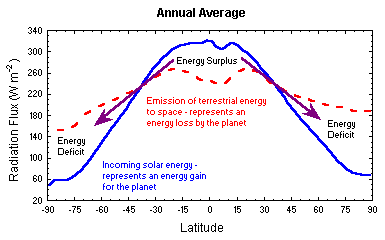
Climate and general circulation of the atmosphere are related to:
Related to the balance of the incoming solar radiation and the outgoing terrestrial radiation emitted by the earth. Over the globe, the energy balance is nearly balanced when averaged over a year (incoming equals outgoing). When averaged over a latitude band, incoming radiation is a surplus in the tropics and deficit of radiation is found in the polar regions due the outgoing terrestrial radiation being larger than the absorbed solar radiation.

To compensate for the surplus and deficit of radiation in different regions of the globe, atmospheric and oceanic transport processes distribute the energy equally around the earth. This transport is accomplished by atmospheric winds and ocean currents.
This model represents the average circulation of the atmosphere and is used to describe the atmospheric transport of energy.
The intense incoming solar radiation in the equatorial region creates rising air. The rising air cools condenses and forms a region of intense clouds and heavy precipitation. This area is call the Inter-Tropical Convergence Zone (ITCZ) and corresponds regions over which the tropical rain forests are found. The ITCZ moves north and south following the sun during the year. Because the stratosphere is stable, rising air that reaches the tropopause moves poleward. By the time the air moving northward reached about 30 N it has become a westerly wind (it is moving to the east) due to the Coriolis force. Because of conservation of angular momentum, the poleward moving air increases speed. The increased speed and the Coriolis force are responsible for the subtropical jet. This poleward moving air piles up (notice on a globe how lines of constant longitude converge) forming an area of high pressure at the surface--the subtropical highs. Some of the air sinks toward the surface. Subsidence inhibits cloud formation and this is the reason many large deserts are found near 30N and 30S. Once the sinking air reaches the ground, some flows to the equator, turning west (in the northern hemisphere) as it goes due to the Coriolis force. This surface air forms the trade winds, that blow steadily from the northeast in the northern hemisphere and southeast in the southern hemisphere.
Some of the diverging air at the surface near 30N moves poleward and is deflected to the east by the Coriolis force resulting in the prevailing westerly winds at the surface. At about 60N the air rises cools and condenses and forms clouds and precipitation. This is the general region of the polar front. Some of this rising air returns equatorward.
Sinking air at the poles warms and results in a high pressure over the poles. At the surface, the poleward moving air gets pulled to the right by the Coriolis force (in the northern hemisphere) forming the polar easterly winds. The cold polar air meets with the warm subtropical air moving poleward and forms the boundary between these two air masses known as the polar front. The warm air from the subtropics pushes up over the cold equatorward moving polar air. This polar front is the source of much of the changing weather in the US, particularly in fall, winter and spring. The large temperature contrast results in the polar front jet stream in the vicinity of the polar front.
Major surface weather characteristics of the Three Cell Model:

The Equatorial Doldrums: Rising air creates calms or doldrums in the equatorial region.
ITCZ: Rapidly upward moving air forms this line of convection often viewed on satellite images.
The Trade Winds: steady northeast winds in the northern hemisphere.
Horse Latitudes: The descending branch of the Hadley cell marked by calm winds and high pressure at the surface.
Prevailing Westerly winds: Major air flow pattern of the midlatitude (i.e., 30N to 60N) regions of the earth.
Polar Front: Boundary between the cold polar air flowing to the equator and the warm subtropical air moving poleward.
Polar Easterly winds: Cold polar air that is moving southwest (in the northern hemisphere) where it eventually meets with the prevailing westerlies to form the polar front.